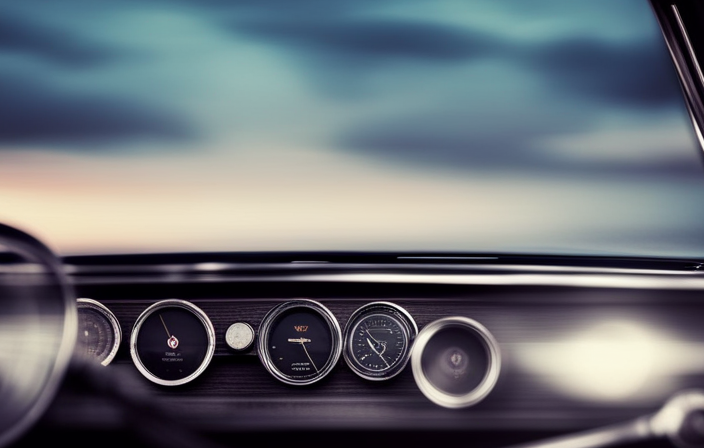Ah, the wonders of cruise control. This incredible function lets us smoothly keep a consistent pace while we drive along sprawling highways. It’s difficult to conceive of an era where this wasn’t a common fixture in our vehicles.
So, when exactly did cruise control become the norm? Well, buckle up, because I’m about to take you on a journey through the evolution of this groundbreaking technology.
Back in the 1960s and 1970s, cruise control was a luxury reserved for the elite few. But as the decades rolled on, advancements in automotive engineering and safety regulations pushed cruise control into the mainstream. By the 1980s and 1990s, it had become a standard feature in many vehicles, offering drivers a newfound convenience and comfort.
Fast forward to the 2000s, and cruise control continued to evolve, incorporating more sophisticated technologies, such as adaptive cruise control and lane-keeping assist. Today, cruise control is a mainstay in modern cars, providing drivers with a range of benefits, from reduced fatigue to improved fuel efficiency.
But like any technology, cruise control has its drawbacks. So, in this article, we’ll dive into both the advantages and limitations of this ever-present feature.
Ready to hit the road? Let’s find out when cruise control became the ultimate driving companion.
Key Takeaways
- Cruise control was initially a luxury feature for high-end vehicles but became more affordable and widespread over time.
- By the mid-1980s, cruise control became a standard feature in most automobiles.
- Cruise control has evolved and integrated with advanced technologies like autonomous driving, adaptive cruise control, lane-keeping assist, and automatic braking.
- Cruise control has been standardized across different car brands and models, improving driving experience and fuel efficiency.
The Invention of Cruise Control
Did you know that cruise control, the invention that changed the way we drive forever, became standard in automobiles in the mid-1980s?
The invention timeline of cruise control dates back to the early 1940s when Ralph Teetor, an engineer who was visually impaired, came up with the idea to maintain a constant speed while driving.
However, it wasn’t until the 1950s that the first commercially available cruise control system was introduced by Chrysler.
Initially, cruise control was a luxury feature only available to early adopters who could afford high-end vehicles.
Over time, as technology advanced and production costs decreased, cruise control became more affordable and widespread.
By the mid-1980s, it had become a standard feature in most automobiles.
Transitioning into the subsequent section, let’s explore the impact of cruise control in the 1960s and 1970s.
Cruise Control in the 1960s and 1970s
Imagine cruising down the highway in the 1960s and 1970s, effortlessly maintaining your desired speed without even touching the gas pedal. During this time, cruise control technology was still relatively new and only available in a limited number of vehicles. However, early adopters of cruise control saw its potential to enhance their driving experience. These pioneers valued the convenience, comfort, and fuel efficiency that cruise control provided. They embraced this innovative feature, recognizing its ability to make long drives more enjoyable and less tiring. As cruise control gained popularity, more car manufacturers began incorporating it into their vehicles. This marked the beginning of the transition towards cruise control becoming a standard feature in cars. With the increasing demand and advancements in technology, the 1980s and 1990s saw cruise control becoming a common and expected feature in most new vehicles.
The 1980s and 1990s: Cruise Control as a Standard Feature
The 1980s and 1990s witnessed a remarkable shift as cruise control seamlessly integrated into every car, revolutionizing the way people experienced the open road.
During this period, cruise control became a standard feature in most vehicles, catering to the growing demand for convenience and comfort.
One significant development was the integration of cruise control with autonomous driving technologies, allowing cars to maintain a constant speed while also adjusting to the surrounding traffic conditions. This advancement not only enhanced safety but also improved fuel efficiency, as the system could optimize acceleration and deceleration based on real-time data.
By carefully managing the throttle and brakes, cruise control systems in the 1980s and 1990s significantly reduced fuel consumption, providing drivers with a cost-effective solution for long-distance travel.
As we move into the 2000s, we will explore the further evolution of cruise control and its integration with emerging technologies.
Evolution of Cruise Control in the 2000s
With the turn of the millennium, cruise control underwent a remarkable transformation, adapting to cutting-edge technologies and paving the way for a new era of driving convenience. The evolution of cruise control technology in the 2000s saw the integration of advanced sensors and cameras, allowing for adaptive cruise control systems that automatically adjust the speed to maintain a safe distance from the vehicle ahead.
Additionally, new features such as lane-keeping assist and automatic braking were introduced, further enhancing the safety and ease of driving. The impact of these advancements on driving habits cannot be overstated. Commuting long distances became less fatiguing, as drivers could rely on cruise control to maintain a steady speed and distance, reducing the need for constant adjustments.
These developments laid the foundation for the cruise control systems found in modern cars today, where it has become an essential feature for many drivers. As we delve into the topic of cruise control in modern cars, we can see how these advancements have revolutionized the driving experience.
Cruise Control in Modern Cars
When it comes to cruise control in modern cars, one key point to discuss is the standardization of this feature across different car brands and models. It’s fascinating to see how cruise control has evolved from being a luxury option to a standard feature in most vehicles today.
Additionally, the integration of cruise control with smart and connected car systems has revolutionized the way we use this technology, allowing for adaptive cruise control and other advanced functionalities.
Looking towards the future, it’s exciting to think about the potential developments and innovations that await us in the realm of cruise control, such as improved safety features and even autonomous driving capabilities.
Standardization across Different Car Brands and Models
Imagine driving your car, effortlessly maintaining a consistent speed without having to worry about constantly adjusting the accelerator pedal, thanks to the convenience of cruise control becoming standard across different car brands and models.
The standardization of cruise control has not been without its challenges. Different car manufacturers had to overcome technical and operational hurdles to ensure the seamless integration of this feature across their vehicles. However, the effort has been worth it, as the impact on driving habits has been significant.
With cruise control becoming standard, drivers can now enjoy a more relaxed and comfortable driving experience, reducing fatigue on long journeys. This has also led to improved fuel efficiency, as the system optimizes the use of the accelerator pedal.
As we move forward, the integration of cruise control with smart and connected car systems will further enhance the driving experience, allowing for even more advanced features and functionalities.
Integration with Smart and Connected Car Systems
After exploring the standardization of cruise control across different car brands and models, it’s now time to delve into its integration with smart and connected car systems.
With the rapid advancements in technology, cars are becoming smarter and more connected than ever before. Smart car technology and connected car systems have revolutionized the way we drive, making our vehicles more efficient, convenient, and safe.
Cruise control has not been immune to these developments. Nowadays, cruise control systems can be seamlessly integrated with smart car features, such as adaptive cruise control that automatically adjusts the speed based on the distance from the vehicle ahead. Additionally, connected car systems enable drivers to control their cruise control settings remotely through smartphone apps or voice commands.
These advancements have undoubtedly enhanced the overall driving experience. Looking ahead, let’s now explore the future developments and innovations in cruise control.
Future Developments and Innovations in Cruise Control
As you explore the future developments and innovations in cruise control, you’ll be amazed at how seamlessly it integrates with advanced driver assistance systems, revolutionizing the way you navigate the roads.
The automotive industry is on the brink of exciting advancements in cruise control, with automation integration being a key focus. Manufacturers are working towards developing cruise control systems that not only maintain a set speed but also adapt to changing road conditions and traffic patterns.
This means cruise control will become more intelligent and capable of adjusting its speed and acceleration to ensure a smoother and safer driving experience. With advancements in sensor technology, cruise control will also be able to detect and react to potential hazards, further enhancing your safety on the road.
These future advancements in cruise control will undoubtedly bring numerous benefits, but they also come with some drawbacks that need to be considered.
Benefits and Drawbacks of Cruise Control
One of the advantages of cruise control is that it allows drivers to maintain a constant speed on long highway stretches, reducing fatigue and improving fuel efficiency. This feature is particularly beneficial during road trips or commutes, as it minimizes the need for constant speed adjustments and allows drivers to relax and focus on the road ahead. Additionally, cruise control can contribute to better fuel economy by optimizing acceleration and deceleration patterns. However, there are also drawbacks to consider. For instance, cruise control may lead to complacency and reduced situational awareness, as drivers may become less engaged in actively controlling the vehicle. Furthermore, cruise control is not suitable for all driving conditions, such as in heavy traffic or on winding roads, where the need for constant speed adjustments is frequent.
| Benefits | Drawbacks |
|---|---|
| Reduces fatigue | Potential complacency |
| Improves fuel efficiency | Reduced situational awareness |
| Allows relaxation | Not suitable for all driving conditions |
Frequently Asked Questions
How does cruise control work?
Cruise control works by maintaining a set speed without the need for constant acceleration. It offers several advantages, such as reducing fatigue and improving fuel efficiency. However, some disadvantages include reduced control in certain situations and potential complacency.
Are there any safety concerns with using cruise control?
There are some safety concerns with using cruise control. While it can improve safety by maintaining a consistent speed, it can also lead to driver complacency and increase the risk of accidents, according to accident statistics.
Can cruise control be used in all types of vehicles?
Using cruise control in different types of vehicles has advantages and disadvantages. It’s like having an extra set of hands on the wheel, but it may not work well in heavy traffic or on slippery roads.
Can cruise control be used in hilly or mountainous terrains?
Yes, cruise control can be used in hilly or mountainous terrains. Some vehicles are equipped with hill descent control, which uses engine braking to maintain a steady speed while descending steep slopes, ensuring a safe and controlled descent.
Are there any limitations to using cruise control in adverse weather conditions?
In adverse weather conditions, cruise control has limitations. It may not be effective in heavy rain, as it can cause loss of traction. Additionally, cruise control in snow can be risky due to reduced visibility and slippery road conditions.
Conclusion
In conclusion, cruise control has come a long way since its invention. Starting in the 1960s and 1970s, it gradually became a standard feature in cars during the 1980s and 1990s. In the 2000s, we witnessed further advancements and improvements in cruise control technology.
Today, cruise control is a common feature found in modern cars, offering convenience and comfort to drivers. However, it’s important to note that there are both benefits and drawbacks to using cruise control, and it’s crucial for drivers to use it responsibly and be aware of its limitations.
Alfons is the visionary leader and driving force behind Voyager Info’s success. As the Editor in Chief, he brings a wealth of experience and an unwavering passion for travel to the helm of our cruise-centric platform.
With a lifelong fascination for exploring new horizons, Alfons discovered his love for the ocean and cruising at a young age. From sailing across pristine Caribbean waters to embarking on daring expeditions to far-flung destinations, he has amassed a treasure trove of first-hand experiences in the world of cruising.











